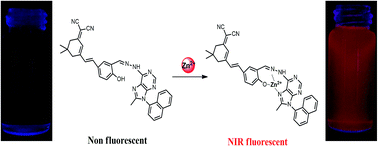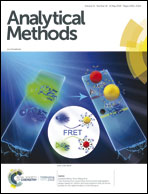A turn-on near-infrared fluorescent probe with rapid response and large Stokes shift for the selective and sensitive detection of zinc(ii) and its application in living cells†
Abstract
Herein, a new near-infrared turn-on fluorescent probe, YPT, was designed and synthesized for the rapid detection of Zn2+, which exhibited low limit of detection for Zn2+ (12 nM) as well as a favorable large Stokes shift (λem − λex = 168 nm). In addition, the probe showed rapid detection progress within 30 s, accompanied by a distinct change in fluorescence from colorless to bright red. Moreover, the sensing mechanism of YPT towards Zn2+ was supported by the Job's plot, HR-MS analysis, 1H NMR titration analysis and density functional theory (DFT) results. In addition, YPT was applied as a visible test strip for the detection of Zn2+. Finally, the NIR fluorescence imaging of Zn2+ was successfully performed in living cells using this probe. All the results indicate that this probe can be used to detect Zn2+ in both solution and living systems.

- This article is part of the themed collection: Analytical Methods Recent HOT articles


 Please wait while we load your content...
Please wait while we load your content...